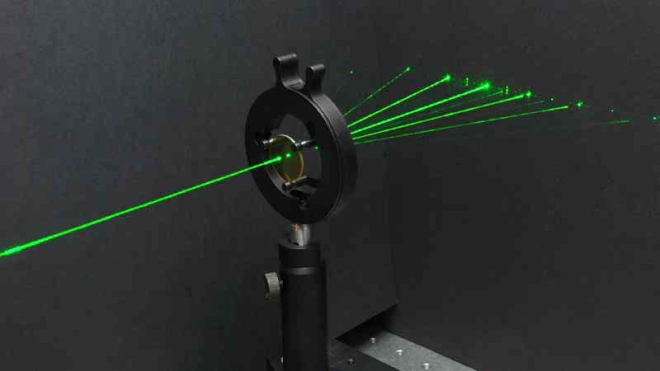08 Jul 2013
Research from the Institute of Photonics and Quantum Sciences (IPaQS) at Heriot-Watt, has the potential to revolutionise how we observe the universe using telescopes, with a new approach that exploits ultrashort pulses of laser light to manufacture optical circuits called ‘photonic lanterns’.
Looking at the universe by ‘lantern light’
Dr Robert Thomson, an expert in ultrafast laser inscription from the Institute of Photonics and Quantum Sciences (IPaQS) at Heriot-Watt University, has developed a new device technology for future telescopes, such as the proposed €1 billion European Extremely Large Telescope (E-ELT), which may facilitate more efficient analysis of the celestial light captured, enabling them to produce more scientific information.
Thomson’s devices are fabricated using ultrashort laser pulses, each only about 0.0000000000001 (or a ten trillionth) of a second long. He uses these pulses to inscribe laser modified ‘tracks’ into a substrate material which then act as optical circuits called ‘photonic lanterns’, and guide photons (particles of light) in much the same way as electronic circuits guide electrons.
Dr Thomson said “Since its invention some 400 years ago, the telescope has become larger and more precise, but its basic design principles have essentially remained the same. Developing new instrument concepts for large-scale telescopes and space-based instruments can be achieved using photonic technologies which, put simply, are the optical equivalent of electronics and enable the flow of light to be precisely controlled and shaped.
“Compared to the traditional optics used in telescopes, such as mirrors and lenses, photonic technologies have the potential to be more efficient and reduce costs. With just one night on a world-leading telescope costing tens of thousands of pounds, it is essential that the instruments on the telescope deliver the maximum scientific output. This is where ‘astrophotonics’ may have the edge over conventional optical technologies.
“By reducing the amount of light that is ‘lost’, and by more efficiently controlling the light that is collected, photonic devices may help increase what can be observed on a telescope, meaning we should be able to learn more about the nature of the universe around us.”
The devices also have more earthly applications, and the technology is already been commercialised for next-generation data communications by Optoscribe Ltd, a spin-out from Heriot-Watt, co-founded by Thomson and his colleagues.
Dr Thomson’s research is funded by the European Union and the UK Science and Technology Facilities Council (STFC).
See also












